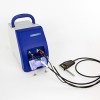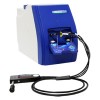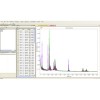
Teaching & Education
Raman spectroscopy is an important analytical tool that gives fundamental molecular spectroscopic information of samples. Because it is used in many applications by chemists, physicists, geologists, used for problem solving and product development in fields including forensics, material science, pharmaceutical discovery and art restoration, it is a valuable component of scientific education. Raman spectroscopy is an important component of instrumental analysis courses. Portable and handheld Raman, with their easy operation, and small footprint are ideal for use in classroom teaching to introduce the fundamentals of Raman spectroscopy. The system can be set up in different laboratories to carry out experiments demonstrating concepts of Raman spectroscopy on a variety of sample types and teach Raman data collection and interpretation. Experimentation can be done to teach how to develop calibrations – both quantitative and qualitative. The portable Raman is equipped with a fiber optic sampling probe that can be used for direct sample measurement, and also be coupled with other sample adaptors optimized for measurement of liquids, tablets, and a microscope for targeted microanalysis. Samples of many shapes and sizes can easily be measured without any sample preparation.
The turn-key portable Raman systems provide research-grade performance. The systems are available with different laser excitations suited for research of different material from graphene and carbon nanotubes to biological samples. Research into surface-enhanced Raman spectroscopy (SERS) can also be done, with the portable Raman system providing easy evaluation of SERS substrates and their efficacy for signal enhancement.
Portable Raman has been introduced into undergraduate courses in forensics, geology, materials science and pharmaceutical sciences so that students are trained in this spectroscopic tool that will assist them in their work. They are better equipped with the knowledge of Raman spectroscopy, and its utility in material identification, structural analysis, forensic analysis and quality control.
B&W Tek offers a full suite of software options that can be used for data acquisition, basic analysis and peak trending, as well as rapid identification with libraries, and more advanced qualitative analysis and quantitative analysis.
Products
High throughput, Highly Sensitive, High Resolution Raman System
Highly Sensitive, High Resolution Fiber Optic Raman System
Testimonials
The NanoRam was the most suitable Raman instrument on the global market, significantly reducing the time spent and as a result increasing the efficiency of our API control process.
— PharmstandardThe NanoRam is so easy to use, and we are now able to get through hundreds of samples per day, allowing us to fulfill regulatory requirements of 100% identification testing of APIs
— HeteroRequest a Quote or Information
Application Notes
Read the full application note
Read the full application note
Read the full application note
View the Series




